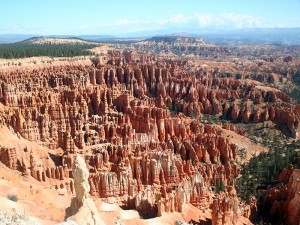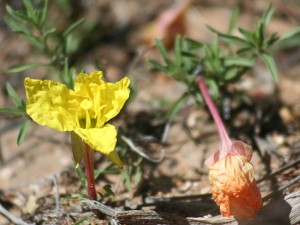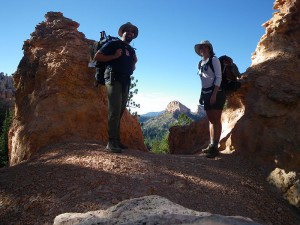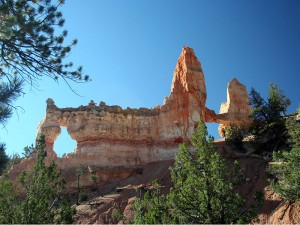It was just an overnight. In and out. But we had to carry all of our water.
We had already been in Bryce Canyon for several days, but we were car camping at one of the developed campgrounds, and we thought we’d give ourselves a true wilderness experience before we left the park.
I wasn’t the one who carried the water. That was Brian’s job. But because he carried the water, I carried all the other gear, including the food in the heavy, bulky and difficult-to-pack bear can. It was wide and round, and was apparently designed to be as awkward as possible to pack. Almost too wide to fit inside the backpack, too roly-poly to strap to the outside. No easy way to pack it, so the best way turned out to be just shoving it in and carrying it however it fit; top-heavy and uncomfortable against my spine.
We hiked 12 and a half miles the first day—more than we usually hike without packs on our backs. We were hiking the Under-the-Rim trail, a 23-mile end-to-end of most of the park, from Rainbow Point at the southernmost tip of the park to Bryce Point, on the south end of the Bryce Amphitheater. All of the trails inside the Amphitheater—around and through the hoodoos, the strange rock formations the park is famous for—were all day hikes, and we knocked those out the first few days were were in the park. So before we even attempted the 23-mile overnight, we had already logged about 25 miles and a few thousand feet of elevation changes.
We hiked down about 2000 feet from the canyon rim at the beginning, grateful that our first big elevation change was downhill since our packs were so heavy. We got plenty of uphill elevation throughout the rest of the day, however, as we hiked up and over ridge lines extending from the rim on our way to our destination, the Swamp Creek backcountry camping area, 12.5 miles in. We walked through rocky dry creek beds, following rock cairns set up by rangers and other hikers that marked the trail—marked it poorly, I might add. We had to stop several times to relocate the trail after following a what we thought was the trail but turned out to be another wash where runoff had cleared the vegetation.
We were ready to stop after about the 8-mile mark. We took our second break of the day there, and we both had a difficult time getting back up. We rallied and pushed onto our actual destination, but those last 4.5 miles were the longest miles I have ever hiked. We hiked up and over another ridge, which led us down and then back up to a grassy plateau where we were surprised to find grazing cattle. It was beautiful, but when we finally stumbled into our camping area and selected a tent site, we could barely walk, let alone set up a tent and make dinner. And then hang the stuff that didn’t fit into the bear can. But we did, because that’s what you do on a backpacking trip.
Once we were in bed—just after sunset, because that was as long as we lasted—a few other hikers walked into camp, arriving even later than we had. They had hiked in from the Swamp Creek connector trail, a mile hike from the rim to where it met up with the Under-the-Rim trail, near our campground. In the morning, as we talked to them, and stretched our tight and sore muscles, we gradually warmed to the idea of hiking out on this trail and then walking the road back to the visitors center. This would only save us about 3 miles out of the 10 that we had planned to hike, but it would save about 1500 feet of cumulative elevation changes. We hiked straight up from the campground to the rim, about 700 feet from where we were, and then we followed a gradual rise and drop to the park shuttle, which dropped us off at the visitors center, where the car was parked.
Our longest hike up to that point had been about 8 miles, so our hike out that day still matched our average daily mileage, and including the hike up to the rim of the canyon, even matched our daily elevation gain. Brian’s pack was 20 pounds lighter that day, even with taking some of the gear out of my pack. He now had room to carry the tent, for example, so even though we hiked 7 miles and climbed 700 feet, the hike felt much easier. We hobbled around for two days after that, proof that we had already done enough distance and elevation for one weekend.
Backpacking trips are always better about a week after they’re over, depending on how far they are and where you go. It’s better to have hiked than to be hiking, sometimes. This one was no different. We’re happy to have done it, but on our next trip, we’ll probably go someplace where we don’t have to carry any water.





{ 2 comments… read them below or add one }
Glad you got to experience Bryce Canyon….such a unique place. We did some mild hiking (compared to yours) but were amazed by its beauty. Enjoyed your blog… Happy Trails! Hugs!
WOW – now I understand why Brian was working out so hard at the gym at Alyeska Resort last winter! He said he was getting conditioned to be able to keep up with you hiking! That is some trip! I honor you for your amazing determination and strength!!! Great accomplishment. The trails in Hawaii will be easy ….. see you soon.